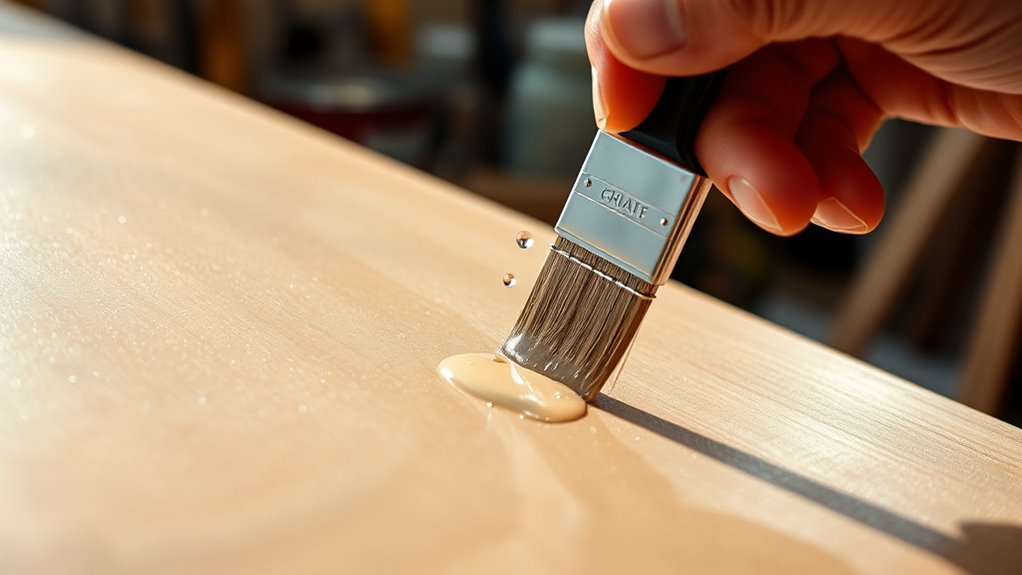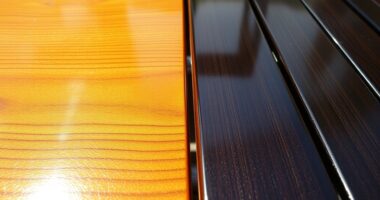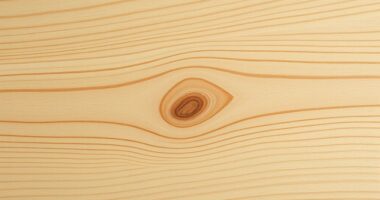Waterborne finishes are a great eco-friendly choice for your projects, emitting fewer VOCs and offering easier cleanup with soap and water. They dry quickly, level smoothly, and require less odor management during application. While they’re durable enough for interior furniture and walls, they may need extra protection for outdoor or high-traffic areas. Proper prep and following manufacturer instructions will help you achieve excellent results—explore more tips to maximize their benefits and long-term performance.
Key Takeaways
- Waterborne finishes emit fewer VOCs and are eco-friendly, promoting sustainable practices with easier cleanup using soap and water.
- They offer quick drying, smooth leveling, and allow multiple coats in less time, simplifying the application process.
- While durable for interior projects, they may require additional treatments for outdoor or high-traffic use.
- Proper surface preparation and adherence to manufacturer instructions are essential for optimal results and durability.
- Ideal for projects emphasizing eco-conscious choices, but consider project demands to balance durability and environmental benefits.

Are waterborne finishes the right choice for your project? If you’re aiming for an eco-friendly option, waterborne finishes are worth considering. They typically emit fewer volatile organic compounds (VOCs) than solvent-based alternatives, making them safer for both the environment and your health. Plus, many brands now offer formulations that emphasize eco-friendly options, allowing you to reduce your project’s carbon footprint without sacrificing quality. These finishes are often easier to clean up, requiring only soap and water, which further minimizes environmental impact.
However, before deciding, you should think about durability considerations. Waterborne finishes have improved considerably over the years, and many now provide excellent hardness and resistance to wear, but they may not always match the longevity of some solvent-based options, especially in high-traffic or outdoor applications. For furniture or interior walls, they tend to perform well, offering good protection and a clear, attractive finish. On the other hand, if your project involves heavy use or exposure to moisture, you might need to select a specific formulation or consider alternative finishes to ensure long-term durability.
Application ease is another advantage of waterborne finishes. They typically dry faster and level out smoothly with less brush or roller marks, making the process less frustrating and more efficient. This means you can often complete multiple coats in a shorter period, saving time and effort. Cleaning your brushes and tools is straightforward as well, requiring only water and soap, which is a big plus if you’re working on a DIY project or trying to keep your workspace tidy. Additionally, waterborne finishes are less likely to emit strong odors during application, enhancing indoor air quality.
On the downside, waterborne finishes can sometimes raise the grain on porous wood, requiring light sanding between coats for the best results. They might also be more sensitive to temperature and humidity during application, so it’s essential to follow the manufacturer’s instructions carefully. While they generally have good UV resistance, some formulations might need a topcoat or additional treatment if the project will be exposed to direct sunlight for extended periods.
Ultimately, if eco-friendliness and moderate durability are your priorities, waterborne finishes can be an excellent choice. They align with sustainable practices, are easier to work with, and produce a beautiful, clear finish. Just keep in mind the specific demands of your project—especially exposure and wear—and choose a formulation that balances eco-friendly options with the necessary durability considerations. With proper application, waterborne finishes can deliver impressive results while helping you stay environmentally conscious.
Frequently Asked Questions
How Long Do Waterborne Finishes Typically Last?
Waterborne finishes typically last 5 to 10 years, depending on durability factors like exposure and surface wear. You should be aware that maintenance requirements influence longevity; regular cleaning and touch-ups can extend their life. Proper application and environmental conditions also play a role. If you follow recommended practices, you’ll enjoy a durable, attractive finish that maintains its appearance over time, making waterborne finishes a smart choice for many projects.
Are Waterborne Finishes Suitable for Outdoor Furniture?
Yes, waterborne finishes are suitable for outdoor furniture because they offer good weather resistance and UV stability. You’ll find that they protect your furniture from rain, sunlight, and temperature changes effectively. Just make sure to apply multiple coats and allow proper drying time for maximum durability. Regular maintenance will keep the finish looking fresh, ensuring your outdoor pieces stay beautiful and protected over time.
Can Waterborne Finishes Be Used Over Oil-Based Paints?
Sure, you can slap waterborne finishes over oil-based paints—if you’re prepared for compatibility concerns. Don’t skip surface preparation, or your new finish might peel faster than a sunburn. The irony is, while waterborne finishes clean up easily, they often struggle to stick over oil-based layers without proper sanding or priming. So, get your surface ready, or your project might end up looking more like a peeling masterpiece than a polished result.
What Are the Best Cleaning Methods for Brushes Used With Waterborne Finishes?
For brush cleaning after using waterborne finishes, you should start by rinsing your brushes with warm water immediately after use. Use a mild soap or brush cleaner to thoroughly remove any residual paint. Gently work the soap into the bristles, then rinse well. To dry, shake out excess water, reshape the bristles, and hang the brush or lay it flat to dry, ensuring good drying techniques that prevent bristle damage.
Do Waterborne Finishes Have Any Health or Safety Concerns During Application?
Sure, applying waterborne finishes is as safe as a walk in the park—if that park’s filled with VOC emissions and skin irritation hazards. You might think you’re off the hook, but these finishes can release volatile organic compounds, causing headaches or respiratory issues. Plus, skin contact might lead to irritation. Always wear gloves, guarantee proper ventilation, and follow safety guidelines to keep your project safe and enjoyable.
Conclusion
Now that you understand the pros, cons, and application tips for waterborne finishes, imagine the projects you’ll transform. But here’s the question—are you ready to unleash their full potential? With a little practice, you’ll discover just how stunning your creations can become. The next coat could be the game-changer, revealing a flawless, durable finish. So, are you prepared to take the leap and see where waterborne finishes can truly take your work?









